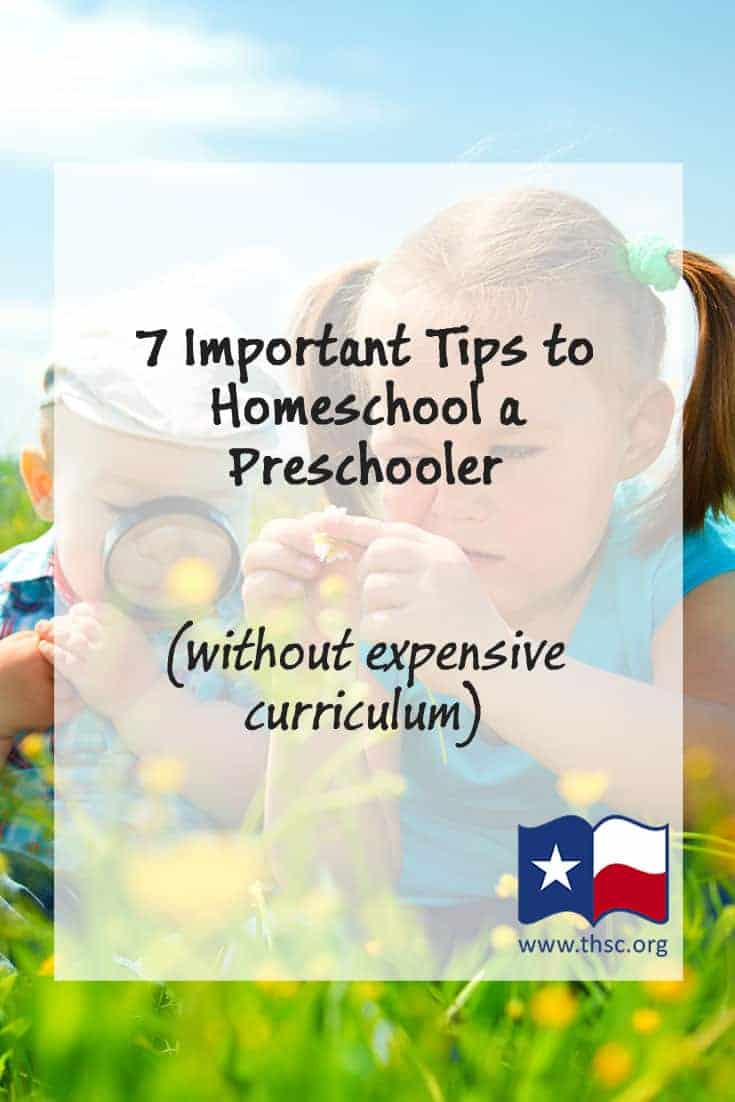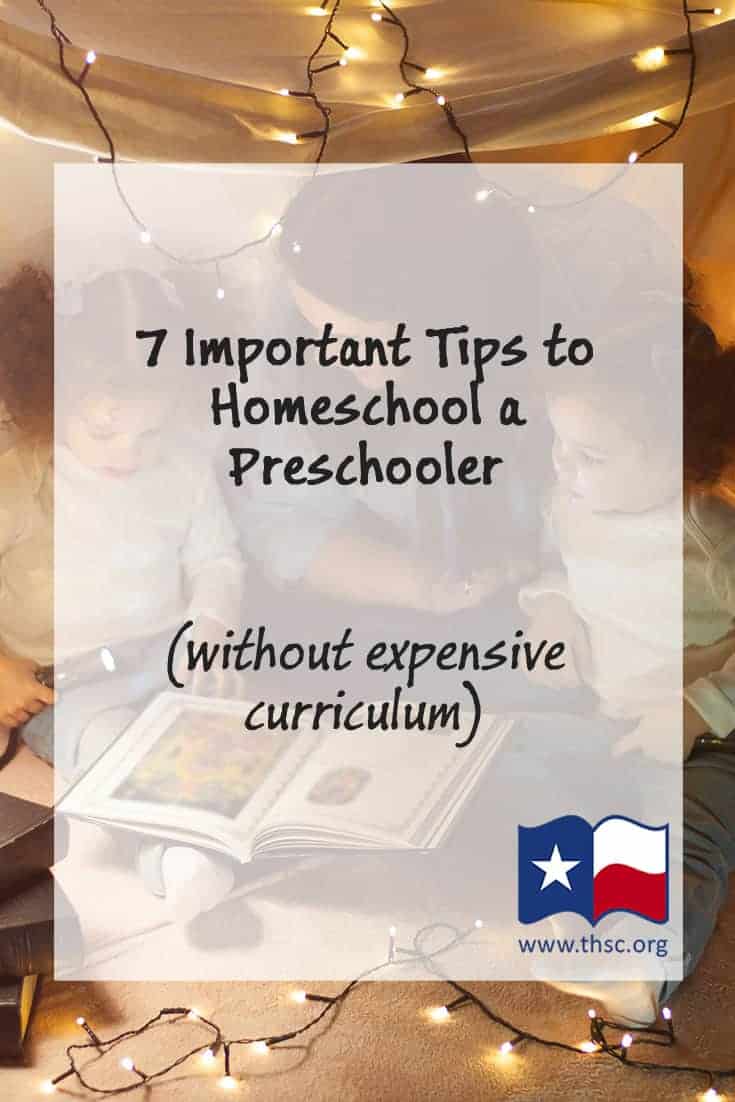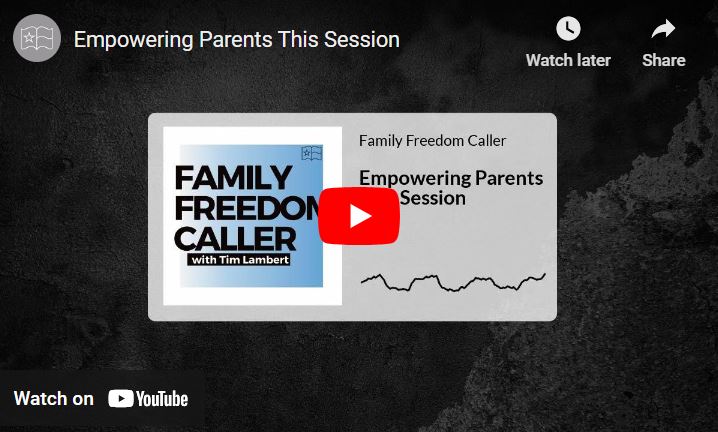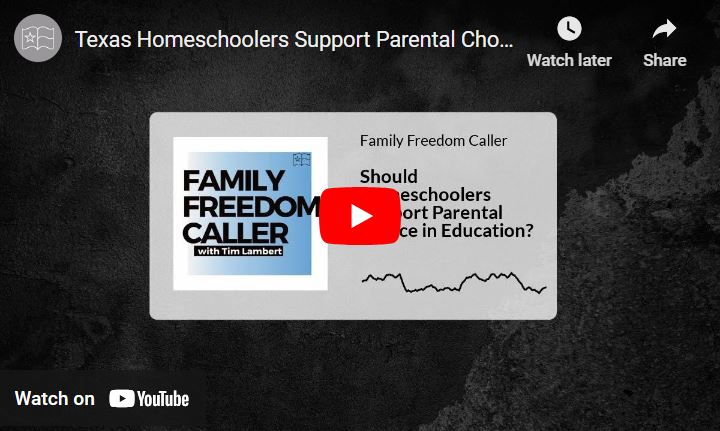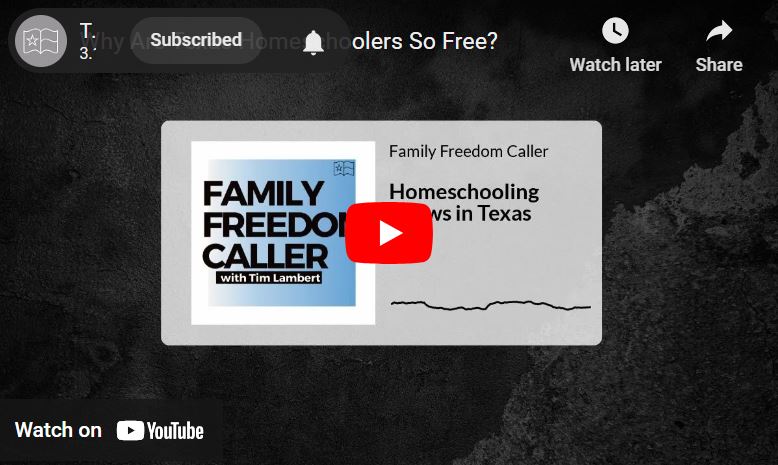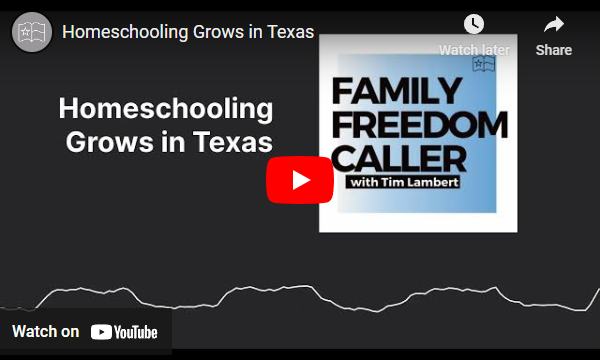Contributors: Diana Johnson, Mary James, Donna Schillinger
Homeschooling your preschooler is a delightful time, with a strong touch of nostalgia. Am I really teaching my little darling, or am I reliving my favorite childhood game of school? It can be a little of both.
Enjoy the fun. Enjoy the sweetness. Enjoy the meandering exploration of preschool schooling. But, be careful about the plethora of materials and preschool homeschool curriculum. If you’re compelled to teach phonics, math and handwriting, limit these to short doses spread throughout the day.
Also, consider these seven tips to be successful at the preschool stage of your homeschool journey.
1. The Goal is Academic Readiness
God has gifted us with wonderful sensory capabilities, which allows learning to take place in the preschool years beyond curriculum aimed at homeschoolers.
Sight, hearing, touch, smell, and taste equip us for understanding the world around us. Preschool teachers have an important role strengthening sensory skills in their little learners, readying them for the academic challenges ahead.
Three key areas of readiness—motor development, visual discrimination and auditory discrimination—are honed on a cluttered path strewn with games, colorful books, wide-eyed conversations, lots of wiggles and cuddly moments. Keep in mind that fun plays a prominent role in sensory development.
2. Rev Their Motor Development
Motor development includes gross motor skills (large muscles) and fine motor skills (smaller muscles).
Because motor development follows a natural pattern of larger muscles developing before smaller ones, it is important to work on those gross motor skills first. In other words, holding a pencil should come after your preschooler can paint letters in very large strokes.
Other activities for building gross motor skills include:
- Hopping on one foot
- Skipping
- Jumping rope
- Throwing and catching a ball
- Walking on a line
- Walking up and down steps without holding onto the railing
You can develop fine motor skills in your preschooler with these activities:
- Stringing beads
- Lacing
- Cutting with scissors
- Buttoning and zipping
- Picking up small objects
- Holding a pencil or crayon
- Playing with Play-Doh
3. Focus on Visual Discrimination
Visual discrimination is the ability to recognize similarities and differences between images. This skill is essential to both reading and writing.
Additionally, sorting, patterning, and sequencing are all skills that require visual discrimination. These skills are also the foundational building blocks of mathematics as part of your preschool homeschool curriculum.
You can help build visual discrimination skills in your preschooler by:
- Matching colors and shapes
- Matching by size
- Sorting silverware
- Spotting the differences in two objects or pictures
- Matching letters and numbers that are the same
Visual memory games are also very helpful in building this skill. For example, show your child a picture and discuss it in detail. Then, cover the picture and ask your preschooler to recall as many details as possible.
Next, show a tray of four or five objects. Then, remove one and have your little learner identify the missing item.
Also, try a visual memory card game like “Guess Who?” This game offers enough challenge to be fun, but not enough to be frustrating.
Visual skills are also sharpened by “hide and find” games or practical real-life applications like looking for baby brother’s pacifier.
4. Did You Hear That? Try Auditory Discrimination
Auditory discrimination is the ability to distinguish between different sounds, such as the sounds of two letters. This is the backbone of phonics that will be appearing in future curriculum.
When homeschooling your preschooler, work with her to build auditory skills by engaging in some of these activities:
- Sound two notes and ask if they are the same or different
- Say pairs of words and ask if they sound the same
- Read poetry
- Play rhyming games
- Clap out a pattern and have the child repeat the pattern
- Have your child identify sounds with their eyes closed
- Take a nature walk and have your child identify sounds
- Play the “Simon Says” game
Building strength in this area will not only help with language skills but also with your child’s overall listening skills.

Another great way to naturally build auditory skills is with the gentle comfort of reading aloud before nap and bedtimes. Yes, you can can even turn sleepy times into learning times!
5. Taste This, Smell That: Preschoolers Learn Through All the Senses
You should invite different tastes and smells into your preschooler’s life. Feast your eyes, ears, and nose on these activities:
- Take a crisp fall walk.
- Visit a garden.
- Take time to smell the roses—literally.
- Savor the crunch of several apple varieties. Side by side, it is amazing how different they can taste.
After completing these activities, interactively listen to your little one’s thoughts on the experience.
Don’t worry if your preschooler halts or rambles as he shares his excitement with you. Let him formulate his thoughts and express what he’s learned.
6. Build Faith and Character in Your Preschooler
While an academic readiness path provides a vital foundation for future academics, eternal rewards are found on the path to spiritual tenderness.
In Matthew 18, we learn that the Kingdom of God is made up of those with childlike faith. What does that mean? Among other things, it means that love and trust come naturally to little children.
Our preschoolers love us without complication because family is the center of their small world. As parents, we are there to love and care for them, and they love and trust us in return. In like fashion, we desire them to simply love and trust God without complication, securely resting in His faithful love and care.
You should nurture this tender faith by sharing your own faith in terms that your preschooler can understand. Here are some other ideas to nurture his love for God:
- Pray with your child and commit his small cares to God together.
- Hide God’s Word in both your hearts by memorizing verses that speak of God’s love and care.
- Read aloud to your child from colorful Bible storybooks.
- Read Bible stories in a rocking chair while holding your preschooler in your arms.
- Walk and talk your love for God with natural simplicity.
- Include your child in household tasks to train their heart for service.
There are many ways to train your preschooler to have a servant’s heart in a homeschooling environment. Have your child get involved when sorting socks, alerting mom when the baby cries, or picking up sticks before Daddy mows the lawn.
These simple activities are powerful as a key ingredient in our preschoolers’ lives, conveying that they are loved by their families and God. This part for academic readiness and spiritual tenderness is an excellent start for any preschooler.
7. Establish a Preschool Homeschool Schedule
You might be wondering how your day should look trying to fit in all these activities and learning tools. After all, how is preschool any different from how I’ve already been teaching my child as a toddler?
Many homeschooling parents are so intentional about parenting that preschool will be a seamless transition. It’s the same good parenting with a little more focus on numbers and letters.
If this describes you, save your money because you probably don’t need to buy preschool homeschool curriculum. Even if you do prefer worksheets and lesson plans, still—save your money! This is one year you can benefit from free downloads, such as those at Homemade-Preschool.com, where everything is free with no log-in.
Also, Confessions of a Homeschooler offers a sample weekly schedule for homeschool to pre-K. One modification we recommend is building in nap time earlier in the day. About half of preschool-aged children still need a nap, so if that nap isn’t keeping your preschooler up at night, let them have it!
Preschool Competencies: Master These 15 Skills Before Kindergarten
Although homeschooling allows considerably more flexibility for the natural developmental differences in children, consider this short list of things most preschoolers should master before kindergarten.
- I can say my first and last name.
- I can write my name using a capital letter and I recognize my name when I see it.
- I can hold a pencil, crayon, and scissors with my thumb, index, and middle fingers.
- I can count to 30.
- I know what numbers come right before and after other numbers.
- I know my shapes.
- I know my colors.
- I know my numbers up to 10.
- I know most of my letters and I even know the sound some of them make.
- I can use my fingers to accurately count items to ten.
- I sit down to read books.
- I open books at the front and turn pages to read them.
- I can make a rhyme.
- I can tell Daddy how my day was and what happened, in order.
- I can sit still while Mommy reads me a book.
There will be a time for reading, handwriting, math, and book reports, but the best use of the preschool years is to focus on activities that encourage the neurological development that will allow your children to perform well. Then, your child will slowly move toward a more structured approach to education.
At this critical preschool age, the time you invest in the early years will provide your child with the skills they need to succeed academically and in life that cannot be taught in their preschool curriculum.
Do you need more tips and resources for how to homeschool your preschooler? Be sure to sign up for THSC email alerts to receive the latest information as we join together Keeping Texas Families Free!
Contributors: Diana Johnson, Mary James, Donna Schillinger
Homeschooling your preschooler is a delightful time, with a strong touch of nostalgia. Am I really teaching my little darling, or am I reliving my favorite childhood game of school? It can be a little of both.
Enjoy the fun. Enjoy the sweetness. Enjoy the meandering exploration of preschool schooling. But, be careful about the plethora of materials and preschool homeschool curriculum. If you’re compelled to teach phonics, math and handwriting, limit these to short doses spread throughout the day.
Also, consider these seven tips to be successful at the preschool stage of your homeschool journey.
1. The Goal is Academic Readiness
God has gifted us with wonderful sensory capabilities, which allows learning to take place in the preschool years beyond curriculum aimed at homeschoolers.
Sight, hearing, touch, smell, and taste equip us for understanding the world around us. Preschool teachers have an important role strengthening sensory skills in their little learners, readying them for the academic challenges ahead.
Three key areas of readiness—motor development, visual discrimination and auditory discrimination—are honed on a cluttered path strewn with games, colorful books, wide-eyed conversations, lots of wiggles and cuddly moments. Keep in mind that fun plays a prominent role in sensory development.
2. Rev Their Motor Development
Motor development includes gross motor skills (large muscles) and fine motor skills (smaller muscles).
Because motor development follows a natural pattern of larger muscles developing before smaller ones, it is important to work on those gross motor skills first. In other words, holding a pencil should come after your preschooler can paint letters in very large strokes.
Other activities for building gross motor skills include:
- Hopping on one foot
- Skipping
- Jumping rope
- Throwing and catching a ball
- Walking on a line
- Walking up and down steps without holding onto the railing
You can develop fine motor skills in your preschooler with these activities:
- Stringing beads
- Lacing
- Cutting with scissors
- Buttoning and zipping
- Picking up small objects
- Holding a pencil or crayon
- Playing with Play-Doh
3. Focus on Visual Discrimination
Visual discrimination is the ability to recognize similarities and differences between images. This skill is essential to both reading and writing.
Additionally, sorting, patterning, and sequencing are all skills that require visual discrimination. These skills are also the foundational building blocks of mathematics as part of your preschool homeschool curriculum.
You can help build visual discrimination skills in your preschooler by:
- Matching colors and shapes
- Matching by size
- Sorting silverware
- Spotting the differences in two objects or pictures
- Matching letters and numbers that are the same
Visual memory games are also very helpful in building this skill. For example, show your child a picture and discuss it in detail. Then, cover the picture and ask your preschooler to recall as many details as possible.
Next, show a tray of four or five objects. Then, remove one and have your little learner identify the missing item.
Also, try a visual memory card game like “Guess Who?” This game offers enough challenge to be fun, but not enough to be frustrating.
Visual skills are also sharpened by “hide and find” games or practical real-life applications like looking for baby brother’s pacifier.
4. Did You Hear That? Try Auditory Discrimination
Auditory discrimination is the ability to distinguish between different sounds, such as the sounds of two letters. This is the backbone of phonics that will be appearing in future curriculum.
When homeschooling your preschooler, work with her to build auditory skills by engaging in some of these activities:
- Sound two notes and ask if they are the same or different
- Say pairs of words and ask if they sound the same
- Read poetry
- Play rhyming games
- Clap out a pattern and have the child repeat the pattern
- Have your child identify sounds with their eyes closed
- Take a nature walk and have your child identify sounds
- Play the “Simon Says” game
Building strength in this area will not only help with language skills but also with your child’s overall listening skills.

Another great way to naturally build auditory skills is with the gentle comfort of reading aloud before nap and bedtimes. Yes, you can can even turn sleepy times into learning times!
5. Taste This, Smell That: Preschoolers Learn Through All the Senses
You should invite different tastes and smells into your preschooler’s life. Feast your eyes, ears, and nose on these activities:
- Take a crisp fall walk.
- Visit a garden.
- Take time to smell the roses—literally.
- Savor the crunch of several apple varieties. Side by side, it is amazing how different they can taste.
After completing these activities, interactively listen to your little one’s thoughts on the experience.
Don’t worry if your preschooler halts or rambles as he shares his excitement with you. Let him formulate his thoughts and express what he’s learned.
6. Build Faith and Character in Your Preschooler
While an academic readiness path provides a vital foundation for future academics, eternal rewards are found on the path to spiritual tenderness.
In Matthew 18, we learn that the Kingdom of God is made up of those with childlike faith. What does that mean? Among other things, it means that love and trust come naturally to little children.
Our preschoolers love us without complication because family is the center of their small world. As parents, we are there to love and care for them, and they love and trust us in return. In like fashion, we desire them to simply love and trust God without complication, securely resting in His faithful love and care.
You should nurture this tender faith by sharing your own faith in terms that your preschooler can understand. Here are some other ideas to nurture his love for God:
- Pray with your child and commit his small cares to God together.
- Hide God’s Word in both your hearts by memorizing verses that speak of God’s love and care.
- Read aloud to your child from colorful Bible storybooks.
- Read Bible stories in a rocking chair while holding your preschooler in your arms.
- Walk and talk your love for God with natural simplicity.
- Include your child in household tasks to train their heart for service.
There are many ways to train your preschooler to have a servant’s heart in a homeschooling environment. Have your child get involved when sorting socks, alerting mom when the baby cries, or picking up sticks before Daddy mows the lawn.
These simple activities are powerful as a key ingredient in our preschoolers’ lives, conveying that they are loved by their families and God. This part for academic readiness and spiritual tenderness is an excellent start for any preschooler.
7. Establish a Preschool Homeschool Schedule
You might be wondering how your day should look trying to fit in all these activities and learning tools. After all, how is preschool any different from how I’ve already been teaching my child as a toddler?
Many homeschooling parents are so intentional about parenting that preschool will be a seamless transition. It’s the same good parenting with a little more focus on numbers and letters.
If this describes you, save your money because you probably don’t need to buy preschool homeschool curriculum. Even if you do prefer worksheets and lesson plans, still—save your money! This is one year you can benefit from free downloads, such as those at Homemade-Preschool.com, where everything is free with no log-in.
Also, Confessions of a Homeschooler offers a sample weekly schedule for homeschool to pre-K. One modification we recommend is building in nap time earlier in the day. About half of preschool-aged children still need a nap, so if that nap isn’t keeping your preschooler up at night, let them have it!
Preschool Competencies: Master These 15 Skills Before Kindergarten
Although homeschooling allows considerably more flexibility for the natural developmental differences in children, consider this short list of things most preschoolers should master before kindergarten.
- I can say my first and last name.
- I can write my name using a capital letter and I recognize my name when I see it.
- I can hold a pencil, crayon, and scissors with my thumb, index, and middle fingers.
- I can count to 30.
- I know what numbers come right before and after other numbers.
- I know my shapes.
- I know my colors.
- I know my numbers up to 10.
- I know most of my letters and I even know the sound some of them make.
- I can use my fingers to accurately count items to ten.
- I sit down to read books.
- I open books at the front and turn pages to read them.
- I can make a rhyme.
- I can tell Daddy how my day was and what happened, in order.
- I can sit still while Mommy reads me a book.
There will be a time for reading, handwriting, math, and book reports, but the best use of the preschool years is to focus on activities that encourage the neurological development that will allow your children to perform well. Then, your child will slowly move toward a more structured approach to education.
At this critical preschool age, the time you invest in the early years will provide your child with the skills they need to succeed academically and in life that cannot be taught in their preschool curriculum.
Do you need more tips and resources for how to homeschool your preschooler? Be sure to sign up for THSC email alerts to receive the latest information as we join together Keeping Texas Families Free!

